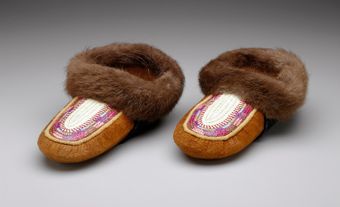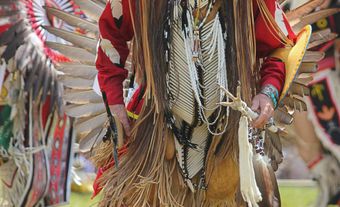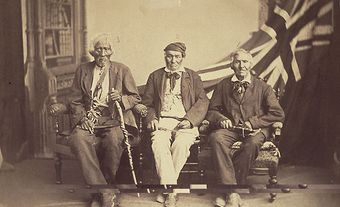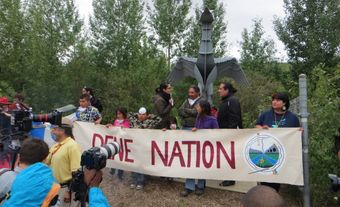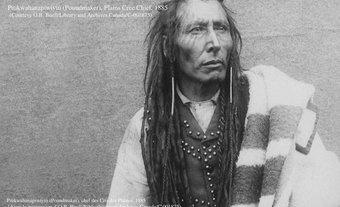History
Though the number of tribes that made up the confederacy is not known for certain, the names of some were identified in the 17th-century records of Jesuit missionaries, including Aondironon, Wenrehronon and Ongniaahraronon. In 1615, Samuel de Champlain referred to all Neutral tribes as the Neutral, or “la Nation neutre” in French, because of their peace with the Five Nations and Huron-Wendat. They were known to the Huron-Wendat as the Attiwandaron (Attiwandaronk, Attawandaron), the meaning of which includes “peoples of a slightly different language” and “people whose speech is awry.” Some scholars argue that the Neutral’s name for themselves was Chonnonton, which means “the people who tend or manage deer.” However, others contend that the Chonnonton were just one of many Neutral nations.
Population
The Neutral were the largest Indigenous society in the Eastern Woodlands during the early 1600s, numbering about 40,000 people. They also had an army of approximately 4,000 to 6,000 warriors. Their population steadily declined throughout the 17th century as a result of famine (1639–41), intertribal wars, and diseases introduced by the Europeans, such as the smallpox epidemics of 1638–40. By 1641, Jesuit missionaries recorded that there were only about 12,000 Neutral remaining. After the destruction of their nation and their dispersal in the early 1650s, Neutral survivors joined other Indigenous nations living to the west and south of their former homeland. Though some claim to trace their lineage to the Neutral, there is no modern Neutral nation with a culturally distinct population.
Traditional Life

The Neutral lived in longhouses in about 40 settlements that included large, fenced-in villages, most of which were concentrated within a 32-km radius of present-day Hamilton, Ontario. Many encampments were situated along the Grand River in the Grand Valley region, which provided an abundant supply of water.
As agriculturists, the Neutral relied on horticultural crops of corn, beans and squash; they also hunted deer, raccoon, wolves, wild cats, squirrels, beavers and turkeys. They augmented their diet with fish, wild apples and chestnuts, and cultivated tobacco for ritual and trade purposes.
Early Economy
In addition to hunting, the Neutral also extracted flint (chert), to make arrowheads for war. In exchange for goods, the Neutral traded flint weaponry with the Huron-Wendat and the Haudenosaunee. These two groups were in a constant state of war with one another throughout the 17th century. By supplying flint weaponry to both sides, and staying out of the conflict, the Neutral remained neutral, hence their name.
Society and Culture
Like many Indigenous groups, the Neutral held various community celebrations and commemorated births, marriages and deaths. The Feast of the Dead was one of their most important and elaborate festivals in which the bones of the dead were placed in a communal burial pit. The Neutral also held feasts and dances to celebrate council meetings, hunting trips and battles. Gift-giving was an important feature of such ceremonies (see Potlatch).
Sport and art also characterized Neutral culture. Games of lacrosse and a hockey-like sport played in the winter “with curved sticks” and “a ball of light wood” were popular. At times, sporting matches between villages continued for several days. The Neutral also enjoyed painting; archaeologists have discovered depictions of humans and animals on stones and wood in former Neutral villages. They also found evidence of tattooing and body-painting, occasionally used for festivals and burial preparation. Unearthed artifacts, such as tools and decorative objects, suggest not only the popularity of painting and tattooing, but also the skill of Neutral artists.
Political System
The Neutral were a ranked society, governed by elected chiefs. Village chiefs presided over various tribal affairs, including trade, war, government, intertribal affairs, justice, feasts and ceremonies. While chiefs were powerful, the Jesuits described the Neutral as individualistic people who discouraged selfish, status-seeking behaviour.
During the 17th century, the confederacy developed into a chiefdom, with paramount warrior-priest-chief Tsouharissen (“Child of the Sun”) at the very top of the socio-political hierarchy. With his council, Tsouharissen united about 10 Indigenous groups within Neutralia, a term coined by Dr. William Noble to describe a geographic area with a high concentration of Iroquoian-speaking peoples. Tsouharissen’s absolute authority over the Neutral was unparalleled in other Northeastern Iroquoian nations at that time. After the death of Tsouharissen in about 1646, the chiefdom failed and the Seneca were able to disperse and destroy the Neutral as a cultural entity in the early 1650s.
Military and Trade Alliances
Despite the neutrality observed with the Huron-Wendat and Haudenosaunee, the Neutral participated in intertribal warfare when they felt the need to protect their territory, people or resources. With the increasing importance of European goods, 17th century Canada saw much warfare between Indigenous nations for control of resources and the trade network with the French. The Neutral held war and trading alliances with surrounding Iroquoian-speaking peoples, particularly the Petun, Huron-Wendat, Wenrohronon (Wenro), Kakwa, Erie, Andasté , Massawomeck and Haudenosaunee further south. They were also allied with the Odawa against the Algonquian-speaking Mascouten of present-day Michigan and Ohio. The Mascouten, or “Fire Nation,” were long-standing, bitter enemies of the Neutral; during the Iroquois Wars in 1643, the Neutral army captured 800 Mascouten prisoners, both male and female, torturing some of them.
In addition to waging war, Neutral warriors transported and protected valuable deer hides and by-products to the Powhatan chiefdom on Chesapeake Bay, where they traded for prized marine Snow Whelk shells (see Wampum). To ensure a steady supply of profitable white-tailed deer hides, the Neutral began penning the animals, a practice that Récollet friar Joseph de la Roche Daillon observed during a visit to Chonnonton territory in 1626.
An increasing dependence on European goods and weapons altered intertribal trade and war alliances. The introduction of firearms overturned the Neutral’s once-powerful position as producers of flint weaponry. The Neutral also increasingly resented the Huron-Wendat’s lucrative position as “middlemen” in Indigenous–French trade. As intertribal tension mounted, armed conflicts and raids occurred between the Neutral and the two nations with which they were once peaceful: the Huron-Wendat and Haudenosaunee.
Contact with Europeans
The Neutral encountered European explorers, such as Étienne Brûlé and Samuel de Champlain, in the early 17th century. Christian missionaries also made contact with the Neutral during this time. In 1626, Récollet friar Joseph de la Roche Daillon spent several months studying the Neutral language and converting them to Christianity. In a brief account dated 18 July 1627, Daillon provided the first study of the customs and territory of the Neutral. He was well received by the people and was even provided personal protection by Tsouharissen. The Neutral saw Daillon as a vital link to French traders and a way to bypass the Huron-Wendat in trade relations with the French. When the Huron-Wendat heard that Daillon might introduce the Neutral to their trading place in the harbour of Cape Victory (Lake St. Peter, St. Lawrence River), they spread false reports about him, declaring him a great and dangerous sorcerer who had killed some Huron-Wendat. The Huron-Wendat raised enough suspicion about Daillon to frighten the Neutral. Fearful for his life, Daillon left Neutral territory for Huronia in 1627.
Thirteen years later, two Jesuit priests, Jean de Brébeuf and Pierre-Joseph-Marie Chaumonot, spent the winter of 1640–41 among the Neutral, teaching them about Christianity. While the priests were not particularly welcome, the Neutral provided them with food, shelter and the basic necessities of life. Brébeuf and Chaumonot recorded information about Neutral ways of life, military alliances and society. Their accounts of the Neutral were printed in the annual Relation, or missionary accounts, which continue to serve as important sources of information about Neutral culture and history.
Dispersal
During the Iroquois Wars of the 17th century, the Neutral fought against former allies, including the Huron-Wendat, for control over resources. However, when the Huron-Wendat nation was destroyed in 1649, the Neutral received Huron-Wendat refugees into their community. Intertribal hostilities increased the following year when 1,500 Haudenosaunee (Seneca and Mohawk) warriors ravaged a Neutral village. Though the Neutral retaliated and took some 200 prisoners, the Haudenosaunee returned the next spring to destroy their nation. According to Jesuits, the Neutral losses were great. Since the missionaries started to arrive in Canada in the 1620s, hundreds of Neutral had been killed by enemies, died of famine or fled their homes in fear.
After the Iroquois Wars, the Neutral scattered to the west and south of their former homeland, becoming assimilated with other Indigenous nations. In July 1653, a band of 800 Neutral survivors were found living in Skenchioe (present-day Tuscola County, Michigan), west of their historic tribal land.
The last reference to the Neutral as a nation in French records was in 1672. Today, no Neutral nation exists, but their descendants are believed to reside in present-day Haudenosaunee communities, including the Wyandotte and Seneca-Cayuga in Oklahoma.
Archaeological Discoveries

Since the mid-19th century, archaeologists have excavated artifacts found in a 500-year-old pre-contact Neutral village. Known as the Lawson site, the area occupies a flat plateau, naturally protected on three sides by steep slopes down to the confluence of Snake Creek and Medway River in present-day northwestern London, Ontario. Although 75 per cent of the Lawson site remains undisturbed, it has yielded more than 30,000 artifacts that provide crucial data about the daily lives of the Neutral. The Lawson village was one of the first archaeological sites to be provincially designated under the Archaeological and Historic Sites Protection Act, and the first archaeological site in Ontario to be placed on the Canadian Register of Historic Places in 2004. Canada has also commemorated the remains of a Neutral village at Southwold Earthworks near St. Thomas, Ontario. The Neutral inhabited Southwold from about 1500 to 1650 CE. Today, the area is recognized as a National Historic Site of Canada.

 Share on Facebook
Share on Facebook Share on X
Share on X Share by Email
Share by Email Share on Google Classroom
Share on Google Classroom



